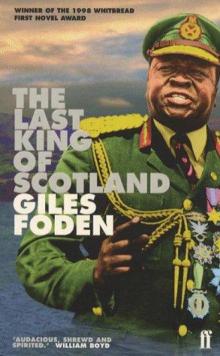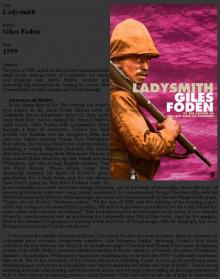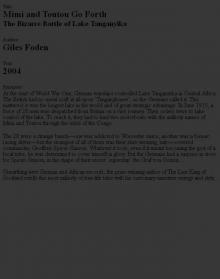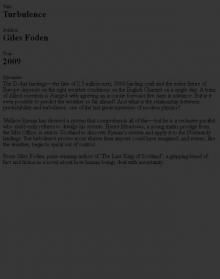- Home
- Giles Foden
2004 - Mimi and Toutou Go Forth Page 4
2004 - Mimi and Toutou Go Forth Read online
Page 4
Much to the bemusement of onlooking Londoners, the expedition paraded at St Pancras railway station before taking the train to Tilbury. Spicer had designed a special uniform for such ceremonial occasions, consisting of army khaki tunics (short sleeved and belted at the waist), grey flannel shirts and navy-blue ties. Each officer, even Dr Hanschell, carried a naval cutlass. Spicer insisted upon this, tearing a strip off the doctor when he questioned the point of a medic wearing such an item. Dressed mostly in this manner the men lined up under the Victorian Gothic portals of St Pancras. The effect cannot have been quite what Spicer intended, given that the ratings were in bell-bottomed sailor’s trousers or khaki shorts, and Tait and Mollison wore kilts. He marched up and down the line all the same, carefully inspecting each man.
This performance was repeated on the quay at Tilbury, whereupon Spicer marched his men up the gangplank of the Llanstephen Castle to the suppressed laughter of the liner’s Merchant Navy officers. Some of the passengers were not so amused, complaining to the captain at this use of the ship for military purposes. Surely it made them more liable to be torpedoed by German U-boats, as had happened to the Lusitania the previous month.
That event, which took more than a thousand lives to the bottom of the sea, puts the scale of the Naval Africa Expedition in some perspective. So, too, does the situation on the Western Front in June 1915 as Spicer’s 28-man team was embarking. Every day, close-ranked units of troops were being cut to ribbons by machine-gun fire as they tried to advance over fields of mud. The mud was caused not by the weather but by the pounding of heavy shells. At Ypres in April the Germans had used poison gas for the first time, releasing it from canisters whose arrival through the air would send troops into panicked retreat.
It seemed as though the Germans were winning. Their dugouts, their steel helmets and most of all their guns were of better quality. In Africa, too, their superiority was evident, though their rifles were mainly old, puff-smoke things—1871-pattern weapons that used black powder and easily gave away a soldier’s position in the bush. Still the Germans were victorious and for a very simple reason: their commander von Lettow knew what he was about and the British did not.
The battle of Tanga the previous November was a case in point. Two brigades of the Indian Army dispatched by ship from Karachi, hoping to take the port of Tanga in the north of German East Africa at the end of their voyage, had suffered a shameful defeat because of poor organisation and bad planning. That battle was the beginning of a long, fiercely fought campaign by von Lettow, which would outlast the war in Europe.
The campaign had a naval element, as the British were trying to ensure naval supremacy in the Indian Ocean. Von Lettow, meanwhile, was desperate to supply his men from Germany. That June, he had only one way of protecting a cargo ship. It was the wily Königsberg, the heavily armed German cruiser, still hiding out in the sinuous green curves of the Rufiji delta. But the British were determined to take it from him.
The Admiralty had ordered the Königsberg 's destruction—orders picked up by the Königsberg’s radio operators on their own aerials. Forewarned is forearmed, as they say. Two shallow-draught British ships, the Severn and the Mersey—both originally intended for the Gallipoli landings—had arrived off the Tanganyikan coast on 3 June ready to hunt the German ship out of its river maze.
This operation would eventually involve Spicer’s men in ways none of them could have anticipated as they boarded the Llanstephen Castle that bright June day in 1915. Their destination was nearly a thousand miles away from the Königsberg on the other side of German East Africa, closer to the copper mines of the Congo and the Mountains of the Moon than the crocodile-infested waters of the Rufiji.
THREE
Vibrating at great volume—rocking and swelling, rumbling and gurgling—the Llanstephen Castle was making her own preparations. It was like something boiling in a saucepan. Down the side of the vessel, visible from her promenade deck, a foam of pumps disturbed the water. Fish gathered in the warmth, tumbling about in the exhausts, and young lads threw lines off the wharf, hoping to catch them. She threw up such a symphony of departure as was typical for ships of her class at that time. The siren sounded—a prolonged, ear-blasting note—and then a shout went up.
‘Any more for the shore? Any more?’ as the last non-passenger scrambled down the gangplank.
Those familiar with the ship would have noticed two strange shapes cowled in tarpaulin on the foredeck: Mimi and Toutou, late of Twickenham and Dundee, denied to the Greek seaplane service by wartime necessity. They were lying in their special cradles, which the ship’s merchant seamen had lashed to the deck. These carriages were squares of timber ‘carcassing’ that created a shell round the boats, with criss-cross struts on either side for extra strength. Inside the cradles, the boats’ hulls sat on rubber tyres to protect them.
Half an hour after the gangplank had been lifted, the liner left her moorings. Towed by a tug, she was pulled out into the main stream of the Thames. The men of the Naval Africa Expedition watched the spectators at the pier fade into the distance and soon the grey buildings of the Tilbury docks were shrinking too. Then the lines of tugs and barges and even the cranes that had towered over them were gone. Soon England itself would be just a memory. Perhaps it was already, as the men’s heads crowded with images of their destination: the dazzling seas, the orange suns, the acacia trees of Africa.
The expedition might also have been conscious of the voice of history at Tilbury—for it was here that Queen Elizabeth had reviewed English troops when the Spanish Armada threatened. But as the ship sailed, the voice that echoed loudest in their ears was that of Spicer.
He was telling Dr Hanschell not to worry about the expedition’s medical supplies, which had not arrived in time to be loaded.
‘We don’t need more than a little quinine, do we? I never had more than that on the Yangtze or in Gambia. We can buy some more in Cape Town. The bar’s open—come and have a drink!’
The doctor obliged, though he was still very worried about the missing drugs. And so, the Naval Africa Expedition—commanded by a man who had yet to reveal his more eccentric qualities—was on its way at last.
Suddenly it seemed terribly important to the Government. Maybe they had realised what Sir Henry had sensed: that control of Lake Tanganyika meant control of a vast swathe of Central Africa. Maybe they were beginning to see that unless Lee’s plan worked, a nightmare possibility could emerge. If victorious in Africa, the Kaiser could conscript hundreds of thousands of African troops—the askaris—to fight in the trenches of Europe. Many colonial troops already fought in the trenches, but complete strategic control of Africa would have taken this to an unprecedented level. There was even the spectre of a great army of askaris marching up through Egypt.
As the Llanstephen Castle left Tilbury a message arrived at the Admiralty from Winston Churchill’s old enemy Bonar Law, now at the Colonial Office: When would operations on Lake Tanganyika start? Can they be speeded up? Von Lettow had been moving troops up and down the lake in steamers, attacking British and Belgian positions at will from his base in Kigoma, the lake’s main port. One minute he seemed to be in Burundi, the next in Rhodesia. How was he moving about so quickly?
No one seemed able to answer this question, though the reason would emerge soon enough. The Belgians were more concerned about potential friction between their officers on the lake and Spicer than with giving the British the full picture. Through Bonar Law, they insisted the following phrase be inserted in Spicer’s orders: ‘You will work in harmony with the Belgian Military Authorities, giving them such aid as may be in your power.’ However, by that time Spicer was well away, entertaining Dr Hanschell in the bar.
As the liner approached the sea, the tug prepared to cast off. Watching through a porthole as he sipped his drink, Dr Hanschell noticed a motor-launch come alongside. A petty officer climbed up the ship’s ladder and one of the crew began hauling up bundles of half-tied cardboard boxes in a net. The
doctor realised they were his medical supplies and went outside to sign for them. The petty officer handed him an invoice, then climbed back down and sped off in his launch.
A relieved Dr Hanschell returned to the bar with this news. Only later, when he opened the packages with Eastwood to check them against the invoice, did he realise that most of the medicines and other equipment he had ordered were missing. He retired to bed feeling rather bitter. There weren’t even any splints…
At 17 miles an hour, with Mimi and Toutou safely tied to its deck, the Llanstephen Castle steamed south. Spicer’s men were allowed a brief respite from their duties as they mingled with other passengers and settled into the pattern of life at sea on a liner. This was beautifully described by Winston Churchill, who had made the same trip to Cape Town just over a decade before, on another ship of the Castle line:
Monotony is the characteristic of a modern voyage, and who shall describe it? The lover of realism might suggest that writing the same paragraph over and over again would enable the reader to experience its weariness, if he were truly desirous of so doing. But I hesitate to take such a course, and trust that some of these lines even once repeated may convey some inkling of the dullness of the days. Monotony of view—for we live at the centre of a complete circle of sea and sky; monotony of food—for all things taste the same on board ship; monotony of existence—for each day is but a barren repetition of the last; all fall to the lot of the passenger on great waters.
However, Churchill also admits that ‘even monotony is not without its secret joy’:
For a time we drop out of the larger world, with its interests and its obligations, and become the independent citizens of a tiny state—a Utopian State where few toil and none go hungry—bounded on all sides by the sea and vassal only to the wind and waves. Here during a period which is too long while it lasts, too short when it is over, we may placidly reflect on the busy world that lies behind and the tumult that is before us.↓
≡ Winston Churchill, London to Ladysmith via Pretoria (Longman, 1900).
If the Utopia of the Llanstephen Castle had a king, it was Spicer. Every evening in the bar, he would hold forth on his skill in hunting big game. Dr Hanschell, who had cheered up on discovering a beautiful brass microscope among his supplies, remembered one night in particular. It is a scene worth picturing…
Before his usual audience of cooing widows and impressionable young men, Spicer is looking glamorous in full-dress uniform. He has his cutlass buckled on and, in his hand, his silver-topped black cane as a prop. The lines of care around his eyes have been temporarily transformed. No longer do they express the dashed hopes of a man whose career has failed, but instead call to mind a life of adventure and an accumulation of escapes from tight spots in the great outdoors. They bespeak the wisdom born of experience—and this is Spicer’s theme, which he warms to with thespian vigour. He is telling a tale of his days as a gunboat captain on the Gambia River in West Africa:
‘The rhino threw up his head, breathing heavily with rage…In an instant, with a sound like thunder, he was pounding straight for me! You know I have my ammunition specially made for me and my finely tempered buliets went right through the animal from stem to stern, piercing lungs, heart, spleen and liver on the way.’
The widows cluck in amazement while the doctor looks aside in embarrassment. He knows there are no rhino to be found in the Gambia, except perhaps in a zoo, if the Gambia had any zoos. But Spicer is untroubled by mere facts as the professional hunter in him gives way to the concerned zoologist.
‘I was really sorry I had to kill him, for these animals are becoming increasingly rare, but of course I had to in self-defence. His horn was exceptionally long—about 27 inches, as I recollect. Anyway, it was so remarkable that I presented it to the Natural History Museum.’
Dr Hanschell was surprised that Spicer’s nose did not grow equally long, Pinocchio-like, at this tall tale. Surely he ought to have been preparing for the task ahead, rather than indulging in such foolish exhibitions of boasting? The Commander didn’t even have a proper map and had shown the doctor where they were going in a Bartholomew’s school atlas, tracing a finger down the long blue streak of the great lake.
Throughout the nineteenth century control of Lake Tanganyika and the area around it had been in some doubt. A Congolese tribe, the warlike Holo-holo, had settled on the shore, ousting the other African tribes that had been there since ancient times. The Holo-holo were superstitious as well as fierce. Their supreme god was Kabedya Mpungu (‘Remote in the Sky’), to whom appeals were made through witch doctors, secret societies and intermediary spirits. Until the arrival of the Arabs, the crossing of the lake by the Holo-holo was the biggest political change the region had seen. The Holo-holo were themselves reacting to the expansion of the Luba tribe in Congo. They brought with them the practice of ordeal by poison and of drowning newborn babies whose top teeth happened to grow first. Arab slave parties began arriving on the lakeshore from 1820; they employed the Holo-holo to guard the slaves and shipments of gold and ivory.
And then the whites came. Among European travellers it was the British explorers Burton and Speke who first reached Lake Tanganyika. Starting from Zanzibar and following the caravan route, they arrived in January 1858. Not content with being the world’s longest freshwater lake,↓ Lake Tanganyika is also the world’s second deepest lake and the lowest point in Africa below sea level.
≡ About 420 miles or, as Spicer put it in his lecture, ‘as long as England from Southampton to the Scottish border’. The average width of the lake is 31 miles.
It has evolved utterly separately, even from the other great African lakes of the Rift, and its depths contain innumerable unique forms of life. ‘It filled us with admiration, wonder and delight,’ wrote Burton on first seeing it:
Beyond a short foreground of rugged and precipitous hill-fold, down which the footpath painfully zigzags, a narrow plot of emerald green shelves gently towards a ribbon of glistening yellow sand, here bordered by sedgy rushes, there clear and cleanly cut by the breaking wavelets. Farther in front stretches an expanse of lightest, softest blue, from thirty to thirty-five miles in breadth, and sprinkled by the east wind with crescents of snowy foam.
In the so-called ‘scramble for Africa’ that took place in the last two decades of the nineteenth century, it was Germany that won Tanganyika and its lake. Britain seized neighbouring Kenya and Uganda. Through a series of sham treaties, the Belgians had already taken the Congo in the 1870s. Many of these treaties were arranged by Stanley, whose activities on behalf of the Belgian King Leopold had spurred on the other powers, especially Germany. Covering roughly the present area of Tanzania, plus Rwanda and Burundi, German East Africa was established in 1885. It would be administered by the Deutsche Ostafrikanische Gesellschaft (German East African Company) until 1890 and thereafter by the Imperial Government. On the far western side of the territory lay the inland sea of Lake Tanganyika.
Despite the takeover by the Government, German East Africa Inc. had proved a profitable enterprise. Between 1900 and 1913, the value of German exports from Tanganyika had risen from 4 million to 27 million marks. The products sent out of the country, in wooden crates bound for Hamburg, included cotton, sisal, coffee, tea and tobacco.
Of these, cotton was the most important. Indeed, its significance in the story of German East Africa cannot be overestimated, though to understand why takes some unpacking. One of the reasons is cotton’s qualities as a material. A fabric with a long staple and great resilience, it can be mechanically processed more easily than wool, silk or linen. It was the first fabric to switch from hand-to machine-weaving in Germany, yet even as late in the Industrial Revolution as 1873 the Germans lagged far behind Britain and America in cotton production. By the turn of the century, establishing a secure national supply had become a matter of national pride for Germany, which never again wanted to submit to the indignities of having to pay hiked-up prices for cotton, as she had done during the N
apoleonic wars and the American Civil War.
Even in peacetime, German industrialists like Karl Supf, a Bremen factory owner, resented having to pay what he described as an ‘annual tribute’ to Britain and America. Powerful figures such as Imperial Chancellor Bismarck advocated independence of supply, and the Colonial Office and industrialists like Supf were constantly agitating for it.
They had a point. In 1900, 80 per cent of Germany’s cotton-was imported from the United States. The remaining 20 per cent they bought from the British: Germany’s main rival for global power. It was decided that Germany would henceforth satisfy her cotton needs with production in the newly established colony of German East Africa. Supf, a colonial enthusiast, emphasised the political benefits of this new economic enterprise. Cotton could be a means of control: ‘Becoming economic master of our colonies depends basically on our succeeding to make the natives dependent on us. Indeed, the economic dependence of the inhabitants will make us real masters of our colonies. The introduction of cotton cultivation as a peasant culture seems to be a very appropriate means of teaching the natives to work while making them at the same time dependent on us.’
German-American experts were brought in to oversee the new venture in Tanganyika. For four years from 1902, a harsh system of agricultural imposition was put in place, as native Africans were persuaded to grow cotton (from foreign seed) through a mixture of threatened and actual violence as well as punitive taxation—measures that eventually provoked the Maji-Maji rebellion of 1905-7.

 The Last King of Scotland (1998)
The Last King of Scotland (1998) Zanzibar
Zanzibar Turbulence
Turbulence The Last King of Scotland
The Last King of Scotland 1999 - Ladysmith
1999 - Ladysmith 2004 - Mimi and Toutou Go Forth
2004 - Mimi and Toutou Go Forth 2009 - Turbulence
2009 - Turbulence